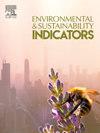土地利用变化影响东印度喜马拉雅地区生态系统净产量
IF 5.4
Q1 ENVIRONMENTAL SCIENCES
引用次数: 0
摘要
在印度东喜马拉雅地区,人类驱动的土地利用变化破坏了碳循环,威胁到重要的生命支持系统,严重影响了全球气候。了解净生态系统生产(NEP)对于评估各种管理系统(如人工林和农林业)的固碳潜力至关重要。本研究旨在量化六种不同土地利用方式的新经济效益:天然林、退化林、橡胶林、槟榔人工林、槟榔农林业和Piper农林业。本研究首次估算了该地区森林、人工林和农林业系统的新经济价值。净初级产量最高的是槟榔农林业(11.35 Mg C ha - 1 yr - 1),最低的是槟榔人工林(5.30 Mg C ha - 1 yr - 1)。碳通过土壤呼吸和采伐发生损失,橡胶林和天然林的年土壤呼吸最高(2.12 Mg C ha−1年−1年−1),次之(1.69 Mg C ha−1年−1)。收获碳损失在天然林中最大(4.80 Mg C ha - 1 yr - 1),在橡胶林中几乎不存在。槟榔复合农林业NEP最高(6.99 Mg C ha−1 yr−1),天然林最低(1.68 Mg C ha−1 yr−1),因为前者具有较高的NPP和较低的碳释放。这些结果表明,槟榔复合农林业比其他土地利用方式(包括天然林)更有效地吸收碳。该研究的结论是,某些管理生态系统的新经济政策可以等于或超过森林生态系统的新经济政策,强调了它们作为基于自然的气候变化缓解解决方案的潜力,以及它们在推进可持续发展目标,特别是可持续发展目标13方面的作用。本文章由计算机程序翻译,如有差异,请以英文原文为准。
Land use change affects net ecosystem production in the Eastern Indian Himalayan region
Human-driven land use changes in the Indian East Himalayan region threaten vital life-support systems by disrupting the carbon cycle, significantly affecting the global climate. Understanding net ecosystem production (NEP) is essential for evaluating the carbon sequestration potential of various managed systems, such as plantations and agroforestry. This study aimed to quantify NEP across six different land uses: natural forest, degraded forest, rubber plantation, Areca plantation, Areca agroforestry, and Piper agroforestry. This study provides the first estimates of NEP in forests, plantations, and agroforestry systems in this region. The net primary production was highest in Areca agroforestry (11.35 Mg C ha−1 yr−1) and lowest in Areca plantations (5.30 Mg C ha−1 yr−1). Carbon loss occurred through soil respiration and harvest, with annual soil respiration highest in rubber plantations (2.12 Mg C ha−1 yr−1) and natural forests (1.69 Mg C ha−1 yr−1). Harvest carbon loss was greatest in natural forests (4.80 Mg C ha−1 yr−1) and nearly non-existent in rubber plantations. NEP was highest in Areca agroforestry (6.99 Mg C ha−1 yr−1) and lowest in natural forests (1.68 Mg C ha−1 yr−1), as the former exhibit high NPP and lower carbon release from the system. These results indicate that Areca agroforestry are more effective carbon sinks than other land uses, including natural forests. The study concludes that the NEP of certain managed ecosystems can equal or surpass that of forest ecosystems, emphasizing their potential as nature-based solutions for climate change mitigation and their role in advancing Sustainable Development Goals, particularly SDG 13.
求助全文
通过发布文献求助,成功后即可免费获取论文全文。
去求助
来源期刊

Environmental and Sustainability Indicators
Environmental Science-Environmental Science (miscellaneous)
CiteScore
7.80
自引率
2.30%
发文量
49
审稿时长
57 days
 求助内容:
求助内容: 应助结果提醒方式:
应助结果提醒方式:


